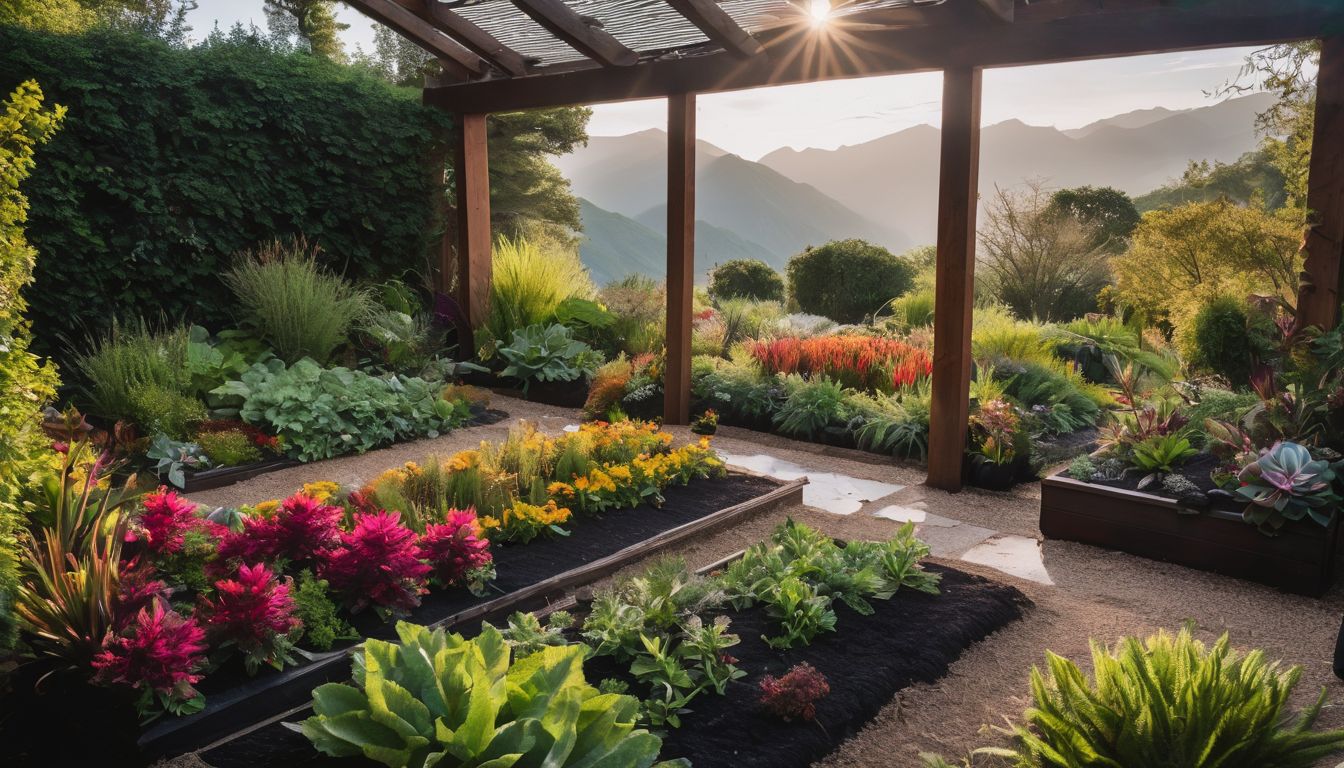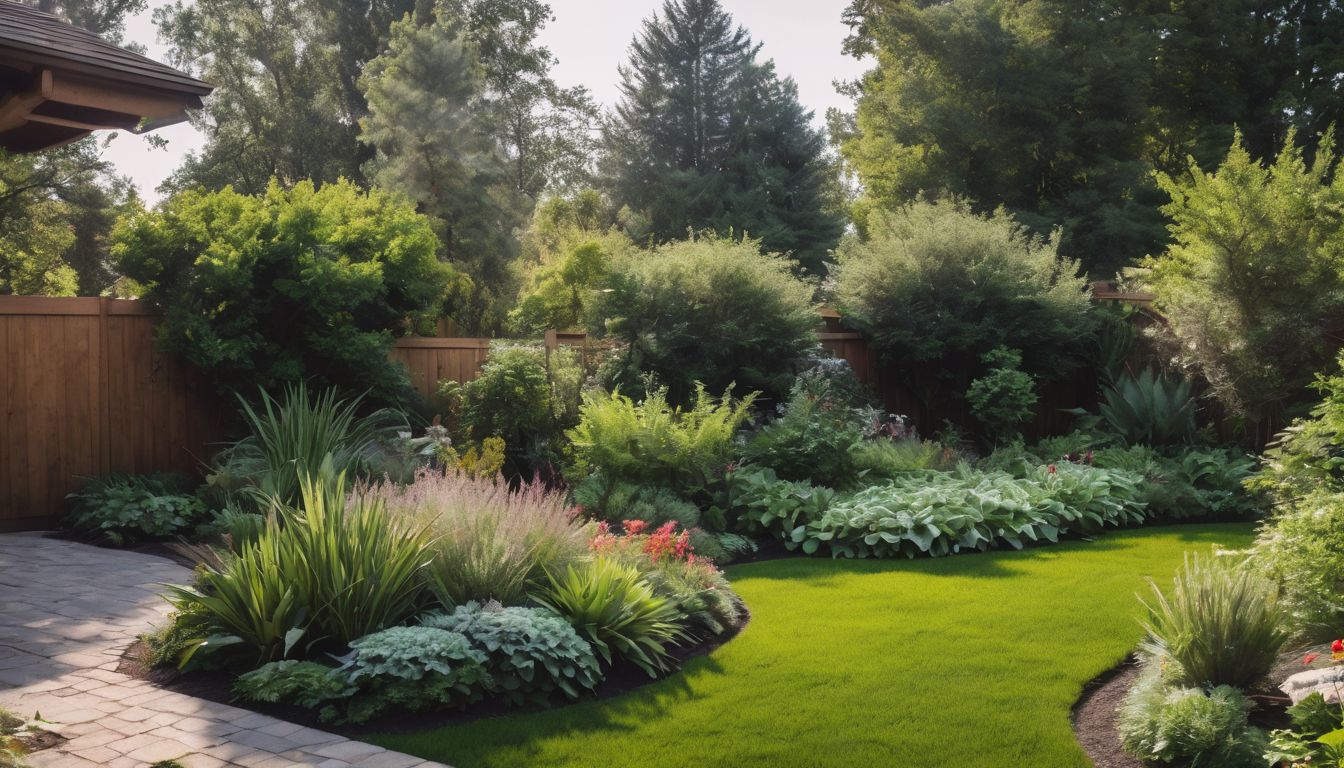Many gardens lack the buzz of wildlife they could have. Gardens that burst with various plants, insects, and birds are not just beautiful—they’re vital for our environment’s health.
In this article, we’ll explore easy ways to enrich your garden’s biodiversity and why it matters so much—for nature’s sake and ours. Dive into a world where every plant and creature plays a part!
Key Takeaways
- Garden biodiversity ensures a balance of different species which is essential for ecological health and resilience against pests.
- Native plants are crucial as they provide suitable food and habitats for local wildlife, helping to maintain natural ecosystems.
- A range of plant varieties, including those that bloom at different times, attracts diverse pollinators and supports year-round garden life.
- Creating habitats with features like birdbaths or ponds not only invites more wildlife but also adds beauty to the outdoor space.
- By building pollinator – friendly areas and avoiding pesticides, individuals can significantly boost the number of beneficial insects in their gardens.
Understanding Biodiversity in Gardens
Biodiversity in gardens refers to the variety and abundance of plant, animal, and insect species within a garden ecosystem. It is crucial for supporting food security, conserving native plant species, and maintaining a healthy environment.
Definition and importance
Garden biodiversity refers to the variety of plant, insect, bird, and other wildlife species that thrive within a domestic garden ecosystem. A diverse garden teems with life and plays a crucial role in maintaining ecological balance.
It mirrors the complex web of interactions seen in nature – where different organisms depend on each other for food, shelter, and survival.
Embracing this diversity isn’t just about creating a beautiful space; it’s integral to fostering resilience against pests and diseases. Diversity in your garden contributes to better soil fertility, enhances pollination rates which benefit crop yields, and supports conservation efforts by providing much-needed habitats.
In essence, nurturing biodiversity is key to sustaining our natural world right from our backyards.
Benefits for food security and plant conservation
Enhancing garden biodiversity contributes to food security by providing a diverse range of plants that can support local ecosystems and provide a sustainable source of food. By cultivating native plant species, gardens contribute to the conservation of important plant diversity, preserving vital genetic resources for future generations.
Additionally, a biodiverse garden attracts beneficial insects and pollinators essential for the successful growth of many edible plants, supporting greater crop yields and enhancing overall food security.
Furthermore, promoting plant diversity within gardens safeguards against potential threats such as diseases or pests that could devastate monoculture crops. This holistic approach not only benefits individual gardeners but also contributes to the broader conservation efforts aiming to protect our planet’s precious biodiversity.
The Role of Home Gardens in Promoting Biodiversity
Home gardens play a crucial role in promoting biodiversity by attracting pollinators and birds, creating habitats for diverse species, and adding water features to support wildlife.
These mini ecosystems contribute to the overall health of the environment.
Attracting pollinators and birds
To enhance biodiversity in your garden, consider attracting pollinators and birds. Planting a variety of native flowers such as lavender, sunflowers, and wild roses can entice bees and butterflies.
Installing bird feeders and birdbaths provides food and water sources for avian species. Creating habitats with nesting materials like twigs and leaves will also attract birds to your garden, contributing to the overall ecosystem health.
By strategically selecting plants that bloom at different times throughout the year, you can ensure a continuous supply of nectar for pollinators. Additionally, leaving some areas of your garden untamed allows for natural habitats to develop, which is beneficial for both insects and birds seeking shelter or nesting sites.
Creating habitats for diverse species
Gardens can be transformed into thriving ecosystems by creating diverse habitats for different species. Incorporating various plants, such as native flowers, shrubs, and trees, provides food and shelter for a range of wildlife including insects, birds, and small mammals.
A mix of plant heights and structures adds layers to the garden, offering numerous microhabitats that cater to different species’ needs.
Furthermore, adding water features like birdbaths or ponds attracts even more wildlife. Water sources provide drinking spots for animals and attract amphibians and other aquatic creatures.
This creates a dynamic environment that supports a wide array of species within the garden ecosystem.
Adding water features
Consider incorporating a water feature, such as a small pond or birdbath, into your garden. These features provide essential hydration for birds and insects. They also create microhabitats that attract wildlife and contribute to the overall biodiversity of your garden.
Water sources like ponds can also support aquatic plant life, which in turn benefits various other species in the ecosystem.
When designing your garden, think about how adding a water feature could benefit the local environment and wildlife while enhancing the visual appeal of your outdoor space. Providing access to clean water is crucial for supporting diverse ecosystems within gardens.
Planting for Biodiversity
Planting for biodiversity involves using native plants and incorporating a variety of plant species to provide food, shelter, and nesting sites for diverse wildlife. By diversifying the plant life in your garden, you can help support a healthy and thriving ecosystem.
Using native plants
Native plants are essential for promoting garden biodiversity. They provide food and habitat for local wildlife, including birds, insects, and small mammals. By using native plants in your garden, you can help maintain the natural balance of your local ecosystem while also reducing the need for pesticides and excessive watering.
Additionally, native plants are well-adapted to the local climate and soil conditions, making them low-maintenance choices for any garden.
Furthermore, planting native species helps preserve regional plant diversity and supports the overall health of the environment. Native plants contribute to a sense of place by connecting us to our surroundings through their historical significance in our region.
Incorporating a variety of plant species
After using native plants to enhance garden biodiversity, another crucial step is incorporating a variety of plant species. This includes selecting plants with different heights, flower shapes, and blooming times to attract a diverse range of pollinators.
Additionally, mixing annuals and perennials creates a continuous supply of nectar and pollen throughout the growing season, further supporting wildlife diversity in the garden.
It’s important to consider flowering times when choosing plant species for your garden. By including early spring bloomers, summer-flowering plants, and fall-blooming varieties, you can provide resources for pollinators at different times of the year.
Steps to Improve Biodiversity in Gardens
By building pollinator habitats, creating butterfly and pollinator gardens, and enhancing water sources, individuals can take simple yet effective steps to improve biodiversity in their own gardens.
This not only benefits the environment but also creates a beautiful and thriving space for plants and wildlife.
Building pollinator habitats
Encourage biodiversity by creating specific areas that cater to the needs of pollinators. You can achieve this by:
- Planting nectar – rich flowers that bloom at different times throughout the year to provide a continuous food source.
- Including a variety of plants with different flower shapes and colors to attract a diverse range of pollinators.
- Providing nesting sites such as bee hotels or leaving patches of bare earth for ground-nesting bees.
- Avoiding pesticide use as it can harm pollinators and other beneficial insects in the garden.
- Conserving natural habitats around your garden to support a healthy population of pollinators.
Creating butterfly and pollinator gardens
To promote biodiversity, consider creating butterfly and pollinator gardens.
- Choose a variety of nectar – rich flowers to attract butterflies and bees such as lavender, cosmos, and coneflowers.
- Incorporate host plants for butterflies like milkweed for monarchs and parsley for swallowtails.
- Ensure there are sunny spots in the garden as butterflies are attracted to warmth and light.
- Provide a water source, such as a shallow dish with wet sand or pebbles for butterflies to drink from.
- Avoid using pesticides as they can harm butterflies, bees, and other beneficial insects.
Enhancing water sources
Enhancing water sources is vital for promoting garden biodiversity. It provides essential hydration for plants and attracts a variety of wildlife to your garden. Incorporating water features such as birdbaths, ponds, or small fountains can significantly enhance the biodiversity of your garden:
- Birdbaths: Adding a birdbath provides a reliable water source for birds and insects, encouraging them to visit your garden regularly.
- Ponds: Constructing a small pond offers habitat not only for aquatic species but also attracts amphibians, insects, and birds.
- Small Fountains: Installing a small fountain can create movement in the water, attracting different species while providing a source of hydration.
Conclusion
In conclusion, garden biodiversity is crucial for supporting a healthy ecosystem. By attracting pollinators and diverse wildlife, home gardens play a key role in promoting biodiversity.
Planting native species and creating habitats are simple steps that can make a big impact. Increasing garden biodiversity not only enhances the natural beauty of your surroundings but also contributes to the preservation of our planet’s delicate balance.
FAQs
1. What does garden biodiversity mean?
Garden biodiversity means having many different types of plants, insects, and other creatures living together in your home or school garden to create a thriving wildlife habitat.
2. Why is it important to have diversity in our gardens?
Having a variety of species in gardens boosts ecosystem productivity and makes sure plants grow well and that insect pollinators can do their job helping plants make seeds.
3. How can we increase biodiversity in our gardens?
You can increase garden biodiversity by creating micro and macro habitats with different kinds of flowers, shrubs, trees, and water features which also helps restore habitats for wildlife.
4. Can cultivating a diverse garden help against biodiversity loss?
Yes! Cultivating plant and invertebrate diversity at home or school gardening contributes to fighting against the global issue of biodiversity loss by providing vital food sources and shelters for many species.
5. How do we know if our garden has good biodiversity?
To measure how biodiverse your garden is, look out for many kinds of plants growing together without any single type taking over; this indicates you’re successfully supporting habitat diversity.





